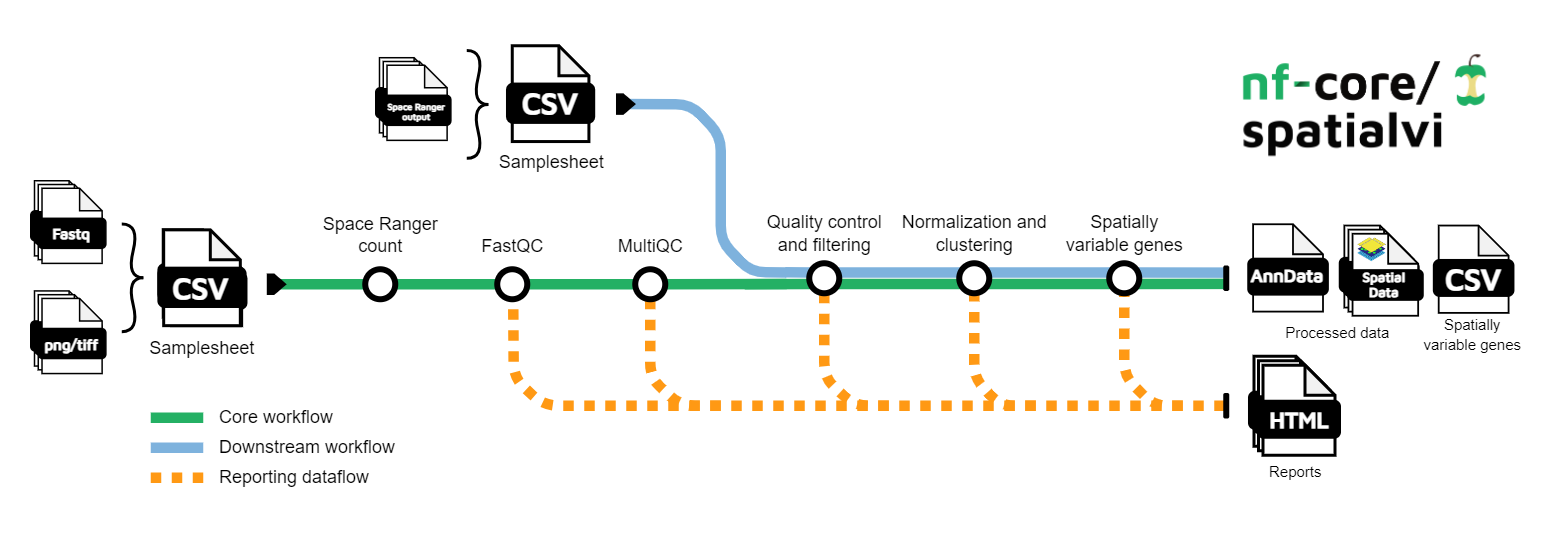nf-core/spatialvi
Pipeline for processing spatially-resolved gene counts with spatial coordinates and image data. Designed for 10x Genomics Visium transcriptomics.
Introduction
nf-core/spatialvi is a bioinformatics analysis pipeline for Visium spatial transcriptomics data from 10x Genomics. It can process and analyse spatial data either directly from raw data by running Space Ranger or data already processed by Space Ranger. The pipeline currently consists of the following steps:

- Raw data processing with Space Ranger (optional)
- Quality controls and filtering
- Normalisation
- Dimensionality reduction and clustering
- Differential gene expression testing
The pipeline is built using Nextflow, a workflow tool to run tasks across multiple compute infrastructures in a very portable manner. It uses Docker/Singularity containers making installation trivial and results highly reproducible. The Nextflow DSL2 implementation of this pipeline uses one container per process which makes it much easier to maintain and update software dependencies. Where possible, these processes have been submitted to and installed from nf-core/modules in order to make them available to all nf-core pipelines, and to everyone within the Nextflow community!
On release, automated continuous integration tests run the pipeline on a full-sized dataset on the AWS cloud infrastructure. This ensures that the pipeline runs on AWS, has sensible resource allocation defaults set to run on real-world datasets, and permits the persistent storage of results to benchmark between pipeline releases and other analysis sources. The results obtained from the full-sized test can be viewed on the nf-core website.
Usage
If you are new to Nextflow and nf-core, please refer to this page on how to set-up Nextflow. Make sure to test your setup with -profile test before running the workflow on actual data.
You can run the pipeline using:
nextflow run nf-core/spatialvi \
-profile <docker/singularity/.../institute> \
--input samplesheet.csv \
--outdir <OUTDIR>Please provide pipeline parameters via the CLI or Nextflow -params-file option. Custom config files including those provided by the -c Nextflow option can be used to provide any configuration except for parameters; see docs.
For more details and further functionality, please refer to the usage documentation and the parameter documentation.
Pipeline output
To see the results of an example test run with a full size dataset refer to the results tab on the nf-core website pipeline page. For more details about the output files and reports, please refer to the output documentation.
Credits
nf-core/spatialvi was originally developed by the Jackson Laboratory1, up to the 0.1.0 tag. It was further developed in a collaboration between the National Bioinformatics Infrastructure Sweden and National Genomics Infrastructure within SciLifeLab; it is currently developed and maintained by Erik Fasterius and Christophe Avenel.
Many thanks to others who have helped out along the way too, especially Gregor Sturm!
1 Supported by grants from the US National Institutes of Health U24CA224067 and U54AG075941. Original authors Dr. Sergii Domanskyi, Prof. Jeffrey Chuang and Dr. Anuj Srivastava.
Contributions and Support
If you would like to contribute to this pipeline, please see the contributing guidelines.
For further information or help, don’t hesitate to get in touch on the Slack #spatialvi channel (you can join with this invite).
Citations
An extensive list of references for the tools used by the pipeline can be found in the CITATIONS.md file.
You can cite the nf-core publication as follows:
The nf-core framework for community-curated bioinformatics pipelines.
Philip Ewels, Alexander Peltzer, Sven Fillinger, Harshil Patel, Johannes Alneberg, Andreas Wilm, Maxime Ulysse Garcia, Paolo Di Tommaso & Sven Nahnsen.
Nat Biotechnol. 2020 Feb 13. doi: 10.1038/s41587-020-0439-x.